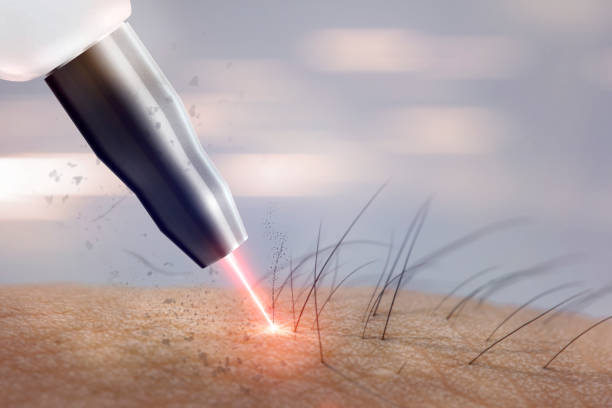Waxing before laser hair reduction can interfere with the effectiveness of the laser treatment. Laser hair reduction targets the hair follicles, and the laser energy is absorbed by the pigment (melanin) in the hair. When you wax, the hair is removed from the follicle, and there is little to no hair left on the skin’s surface for the laser to target.
For laser hair reduction to be successful, the hair needs to be present in the follicle so that the laser can effectively destroy it. Waxing removes the hair from the root, temporarily disrupting the hair growth cycle. This means that when you wax before laser hair reduction, you may not have enough hair in the follicles for the laser to effectively target, potentially reducing the treatment’s effectiveness.

To ensure the best results from laser hair reduction, it is generally recommended to avoid waxing or plucking the hair for a few weeks prior to the treatment. Instead, you should shave the treatment area if hair removal is necessary. Shaving allows the hair to remain in the follicle, which allows the laser to effectively target the hair during the treatment.
It’s important to consult with a qualified professional or dermatologist who specializes in laser hair reduction to get specific instructions based on your unique circumstances and the recommendations of the laser hair reduction system being used. They will be able to provide you with the most accurate and personalized advice regarding preparation for the treatment.
How long before laser should I not wax?
The specific timeframe for avoiding waxing before laser hair reduction can vary depending on the individual, the area being treated, and the recommendations of the professional performing the treatment. However, a general guideline is to refrain from waxing or plucking the hair for at least four to six weeks before your laser hair reduction session.
This timeframe allows the hair to grow back and ensures that there is sufficient hair present in the follicles for the laser to target effectively. The hair should be visible above the skin’s surface but not too long, as excessive hair length may require trimming before the laser treatment.
It’s important to note that these guidelines can vary based on the specific laser hair reduction system being used, the treatment area, and individual factors such as hair growth rate. To ensure you receive the most accurate instructions, it is recommended to consult with a qualified professional or dermatologist who specializes in laser hair reduction. They will be able to provide you with personalized guidelines based on your unique circumstances.
How long after waxing can I start laser hair removal?
You should wait at least 4–6 weeks after waxing before starting laser hair removal. Here’s why:
Why the wait?
Laser hair removal targets the pigment in the hair follicle. Waxing removes the hair from the root, meaning there’s no hair follicle present for the laser to target immediately after waxing. You need to wait for the hair to grow back enough from the follicle to be visible and active under the skin.
What to do instead:
Before your laser session, shave the area 24–48 hours prior — shaving preserves the follicle while keeping the surface clean for treatment.
Summary:
-
Wait time after waxing: 4–6 weeks
-
Before your laser session: Shave, don’t wax or pluck
-
Avoid: Tweezing, waxing, or epilating between laser sessions

What happens if you can’t shave before laser hair removal?
If you are unable to shave before a laser hair removal treatment, it may impact the effectiveness and safety of the procedure. Shaving the treatment area is typically recommended prior to laser hair removal because it ensures that the hair is short enough for the laser to effectively target the hair follicles while minimizing the risk of surface burns or discomfort.
Here are some potential consequences of not shaving before laser hair removal:
- Reduced effectiveness: Longer hair can scatter or absorb more of the laser energy, reducing the laser’s ability to effectively target the hair follicles. This can result in less efficient hair reduction or require higher laser energy levels, which may increase the risk of adverse effects.
- Increased discomfort: When longer hair is subjected to laser energy, it can cause more heat and discomfort during the treatment. Shaving beforehand helps to reduce this discomfort by focusing the laser energy on the hair follicles beneath the skin’s surface.
- Increased risk of surface burns: If longer hair is present on the skin’s surface, it can potentially singe or burn during the laser treatment. Shaving helps minimize this risk by removing hair from the surface, allowing the laser to target the follicles directly.
It’s important to consult with the clinic or professional performing your laser hair removal treatment to understand their specific guidelines and recommendations regarding shaving. If you are unable to shave, they may be able to provide alternative solutions or reschedule the appointment to a time when shaving is possible.
How close to shave before laser hair removal?
The recommended time to shave before laser hair removal can vary depending on the specific guidelines provided by the clinic or professional performing the treatment. However, in most cases, it is advised to shave the treatment area one to two days prior to your laser hair removal session.
Shaving a day or two before the treatment ensures that the hair is short enough for the laser to effectively target the hair follicles. It allows the laser energy to penetrate the hair shaft and reach the follicle, which is the target for destruction during the procedure. Additionally, shaving a couple of days before the session helps to minimize the risk of surface burns or discomfort during the treatment.
When shaving before laser hair removal, it’s important to use a clean, sharp razor to achieve a close shave. Avoid using dull razors, as they can cause irritation and may not provide a clean shave. It’s also recommended to avoid any creams, lotions, or oils on the treatment area before shaving, as these can interfere with the laser’s effectiveness.
However, it’s important to note that these recommendations may vary based on the specific laser system being used and the preferences of the professional performing the treatment. It’s always best to consult with the clinic or professional providing your laser hair removal to receive the most accurate and personalized instructions for shaving before your session.
